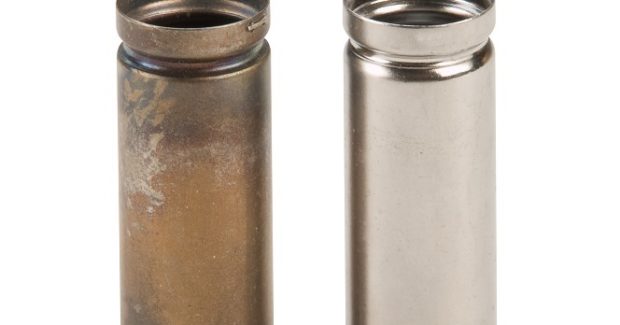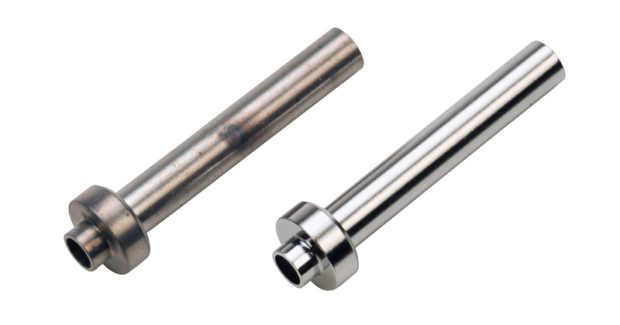Seven Critical Steps for Submitting Samples for Electropolishing
Recognized for the uniform, bright polish it leaves on metal surfaces, electropolishing is highly effective for finishing small, complex, fragile parts as well as larger parts. To properly test its effectiveness, it’s important to submit your sample parts in the correct way to ensure the best results.
Posted: May 29, 2019
Sometimes referred to as a “reverse plating” process, electropolishing uses an electrolytic chemical bath to remove a uniform layer of surface material. It is well recognized for the beautiful, bright polish it leaves on metal surfaces, and it provides other vital benefits as well. Using no abrasives or part-to-part contact, it is as highly effective on small, complex, fragile parts as well as larger parts. The most definitive way to tell if electropolishing will produce an optimal finish on your part that meets all of your requirements is to submit a sample for testing. Along with the part itself, seven critical pieces of information will be needed.
1. CURRENT SURFACE PROBLEM
Electropolishing, which can be used on nearly any alloy, can address the most common surface problems, regardless of the complexity of the part. When having a part tested to see if electropolishing is a good finishing method option, it is important to identify the problems you have so the electropolishing process can be tailored to your needs. These may include:
- Burrs that result from grinding or machining can prevent parts from moving freely or fitting together as closely as is required. In medical devices, a burr may flake off and create a possible bio-hazard for a patient. Importantly, electropolishing can remove micro-burrs, but any large burrs would need to be addressed prior to treatment.
- Corrosion. Depending on their environment and application, parts may be prone to corrosion.
- Premature part failure. The defects and surface anomalies left by metalworking operations such as forming, stamping and electrical discharge machining, can create stress fractures in springs or a weak recast layer in a variety of parts. If not addressed, these conditions can cause the parts to fail and not achieve the desired cycle life.
- Microfinishing problems can affect part fit and function and be tied to premature part failure. Microfinish values can be reduced by up to 50 percent with electropolishing.
2. CURRENT FINISHING METHOD
The purpose of gathering this information is to have a baseline and comparison for the results of electropolishing. Common finishing methods include:
- Passivation is designed to improve corrosion resistance by removing free iron from surface. It does not remove imbedded contaminants, heat tint or oxide scale.
- Blasting leaves impurities in the pores of the metal that can create initiation sites for corrosion. The blasting process leaves a matte finish.
- Tumbling – The abrasive grit gives inconsistent results and can damage parts as they come in contact with each other.
- Pickling – The acids used are too corrosive for certain alloys and can cause etching that, ultimately, results in pitting and intergranular attack.
- Metal plating – To protect a part from corrosion, a layer of metal is deposited on the surface. The plating is susceptible to peeling and abrading exposing the base material.
- Mechanical polishing is a labor-intensive process that uses various abrasives to smear the surface metal to blend or remove imperfections on metal parts. It often has inconsistent results.
- Vibratory finishing – Because the basic process involves vibrating the part in an abrasive media and lubricant, it may distort fragile parts.
3. COMPOSITION OF THE PART’S MATERIAL
From titanium to stainless steel, electropolishing can be applied to virtually any metal alloy, but it is important to know your component’s exact makeup in a testing scenario. Different series of stainless steel, for example, may react differently to the process.
4. SPECIAL TOLERANCES REQUIRED
To achieve the ultimate goal of a completely smooth, debris-free surface, the process of electropolishing removes a uniform amount of a part’s surface layer. The part will be closely monitored to ensure that it meets critical dimensional requirements and tolerances.
5. PRINTS OF PARTS
A well-developed part print will have information including dimensions, critical areas and tolerances. Having this information allows for the most thorough and detailed monitoring of the electropolishing process to ensure that the removal of the surface material will be accurate and yield the required finish.
6. TESTING WITHIN BATCHES
It is prudent to sample a part using different material removal and fixturing locations to see how variations in the electropolishing process affect the outcome. This is especially important when trying to deburr a part. Until samples are processed, it is tough to gauge how much material removal will be necessary.
7. PACKAGING REQUIREMENTS
Fragile components and those used in highly sanitary applications often require special packaging. They may need to be individually wrapped or bagged or placed in cell trays. It is important to advise the type of packaging that is necessary when asking for a quotation. When making a decision on which electropolisher to use, make sure that they can provide the necessary packaging so parts can be shipped without damage. This is one critical factor that is often overlooked in the design phase of manufacturing.







